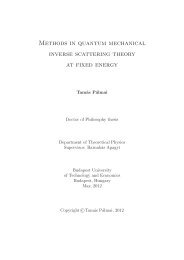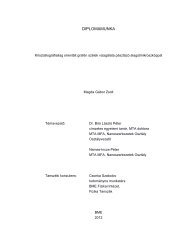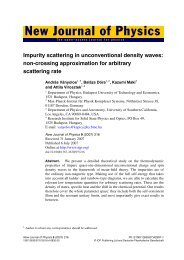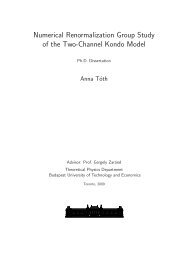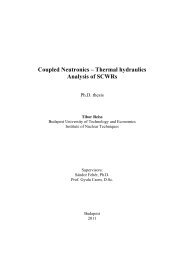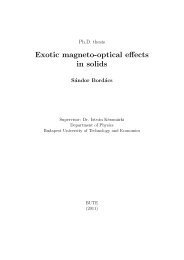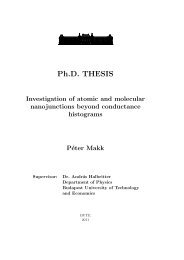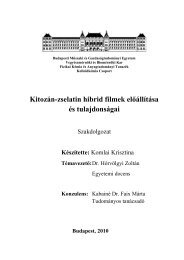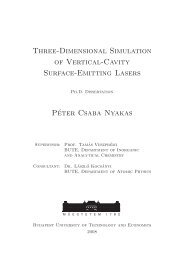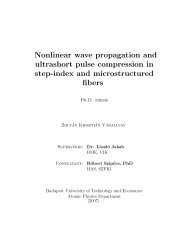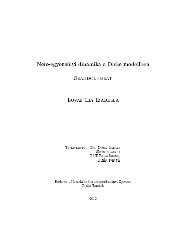Ph.D. THESIS Multipolar ordering in f-electron systems
Ph.D. THESIS Multipolar ordering in f-electron systems
Ph.D. THESIS Multipolar ordering in f-electron systems
Create successful ePaper yourself
Turn your PDF publications into a flip-book with our unique Google optimized e-Paper software.
Chapter 3 Octupolar Order<strong>in</strong>g of Γ 8 Ions 49<br />
0<br />
–1 1<br />
c6<br />
Figure 3.7: Zeeman spectrum of the Γ 8 quartet <strong>in</strong> H‖(111) magnetic field as a function<br />
of the sixth order crystal field coefficient c 6 . We choose the forth order coefficient as<br />
c 4 = 1.1. The Zeeman splitt<strong>in</strong>g consists of a doublet and two s<strong>in</strong>glets at a special ratio of<br />
the crystal field coefficients c 6 /c 4 = −0.2422.<br />
transitions. It can be shown that the relation (3.28) rema<strong>in</strong>s valid even at a<br />
tricritical po<strong>in</strong>t, <strong>in</strong> which case sometimes the quadratic term <strong>in</strong> the equation<br />
of the phase boundary is absent. Besides, a tricritical po<strong>in</strong>t has a special<br />
set of critical exponents even <strong>in</strong> Landau theory. For example, the specific<br />
heat will diverge <strong>in</strong> accordance with its α t = 1/2 mean-field exponent value.<br />
Therefore, it is not straightforward to see how the relation (3.28) will be<br />
satisfied. We will show this <strong>in</strong> our model not too far below.<br />
The results shown <strong>in</strong> Fig. 3.6 were derived for J quad = 0, but this is not an<br />
essential restriction. The relationship (3.28) holds everywhere along the l<strong>in</strong>es<br />
of cont<strong>in</strong>uous phase transitions shown <strong>in</strong> Fig. 3.3. As long as we are deal<strong>in</strong>g<br />
with ord<strong>in</strong>ary second order transitions, Landau theory would be consistent<br />
with all the discont<strong>in</strong>uities appear<strong>in</strong>g <strong>in</strong> (3.28) be<strong>in</strong>g f<strong>in</strong>ite.<br />
Approach<strong>in</strong>g a tricritical po<strong>in</strong>t ∆C → ∞, and (3.28) allows several scenarios:<br />
• a H ≠ 0 case<br />
In the expression (3.27) of the parameter a H , the coefficient of g H<br />
vanishes at the tricritical po<strong>in</strong>t, while <strong>in</strong> general cases, parameter y H<br />
is non-zero, therefore a H rema<strong>in</strong>s f<strong>in</strong>ite. Our expectation is that the<br />
divergence of the ∆C causes the same divergence of ∆∂χ/∂T .<br />
• a H = 0 case<br />
For most of the problems dealt with <strong>in</strong> this Chapter, the special choice<br />
(3.1) of the Γ 8 basis is <strong>in</strong>consequential. However, we may regard the



